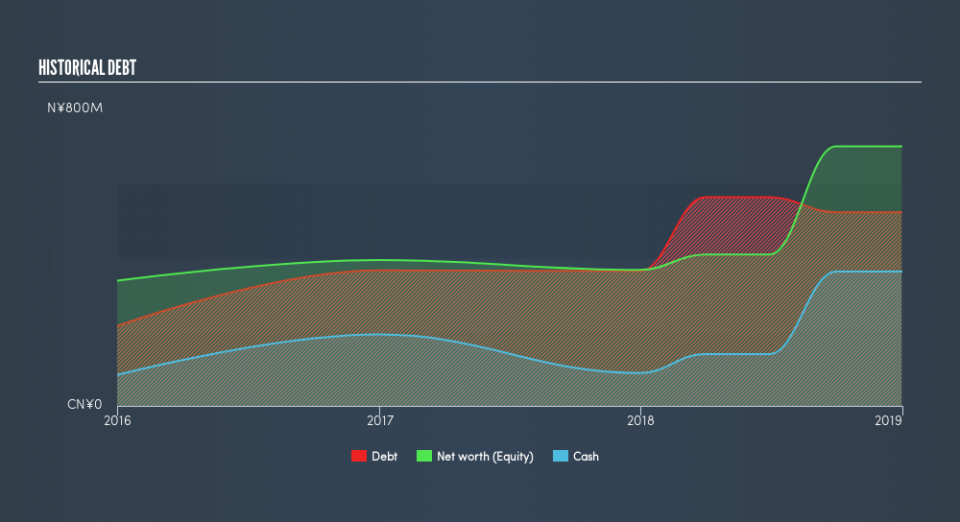What You Should Know About Pacific Millennium Packaging Group Corporation's (HKG:1820) Financial Strength

Want to participate in a short research study? Help shape the future of investing tools and you could win a $250 gift card!
Investors are always looking for growth in small-cap stocks like Pacific Millennium Packaging Group Corporation (HKG:1820), with a market cap of HK$1.4b. However, an important fact which most ignore is: how financially healthy is the business? Assessing first and foremost the financial health is vital, since poor capital management may bring about bankruptcies, which occur at a higher rate for small-caps. We'll look at some basic checks that can form a snapshot the company’s financial strength. Nevertheless, potential investors would need to take a closer look, and I’d encourage you to dig deeper yourself into 1820 here.
1820’s Debt (And Cash Flows)
1820 has built up its total debt levels in the last twelve months, from CN¥364m to CN¥522m , which is mainly comprised of near term debt. With this growth in debt, 1820 currently has CN¥363m remaining in cash and short-term investments to keep the business going. Moreover, 1820 has produced CN¥154m in operating cash flow in the last twelve months, resulting in an operating cash to total debt ratio of 29%, signalling that 1820’s current level of operating cash is high enough to cover debt.
Can 1820 meet its short-term obligations with the cash in hand?
Looking at 1820’s CN¥932m in current liabilities, it seems that the business has maintained a safe level of current assets to meet its obligations, with the current ratio last standing at 1.28x. The current ratio is calculated by dividing current assets by current liabilities. Generally, for Packaging companies, this is a reasonable ratio as there's enough of a cash buffer without holding too much capital in low return investments.
Does 1820 face the risk of succumbing to its debt-load?
1820 is a relatively highly levered company with a debt-to-equity of 75%. This is somewhat unusual for small-caps companies, since lenders are often hesitant to provide attractive interest rates to less-established businesses. No matter how high the company’s debt, if it can easily cover the interest payments, it’s considered to be efficient with its use of excess leverage. A company generating earnings before interest and tax (EBIT) at least three times its net interest payments is considered financially sound. In 1820's case, the ratio of 5.74x suggests that interest is appropriately covered, which means that debtors may be willing to loan the company more money, giving 1820 ample headroom to grow its debt facilities.
Next Steps:
Although 1820’s debt level is towards the higher end of the spectrum, its cash flow coverage seems adequate to meet obligations which means its debt is being efficiently utilised. This may mean this is an optimal capital structure for the business, given that it is also meeting its short-term commitment. Keep in mind I haven't considered other factors such as how 1820 has been performing in the past. I recommend you continue to research Pacific Millennium Packaging Group to get a better picture of the small-cap by looking at:
Future Outlook: What are well-informed industry analysts predicting for 1820’s future growth? Take a look at our free research report of analyst consensus for 1820’s outlook.
Valuation: What is 1820 worth today? Is the stock undervalued, even when its growth outlook is factored into its intrinsic value? The intrinsic value infographic in our free research report helps visualize whether 1820 is currently mispriced by the market.
Other High-Performing Stocks: Are there other stocks that provide better prospects with proven track records? Explore our free list of these great stocks here.
We aim to bring you long-term focused research analysis driven by fundamental data. Note that our analysis may not factor in the latest price-sensitive company announcements or qualitative material.
If you spot an error that warrants correction, please contact the editor at editorial-team@simplywallst.com. This article by Simply Wall St is general in nature. It does not constitute a recommendation to buy or sell any stock, and does not take account of your objectives, or your financial situation. Simply Wall St has no position in the stocks mentioned. Thank you for reading.

